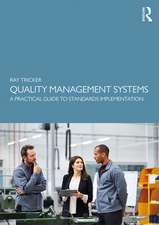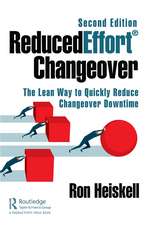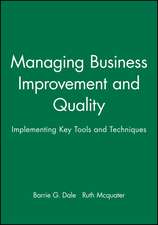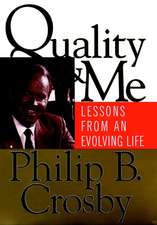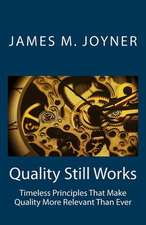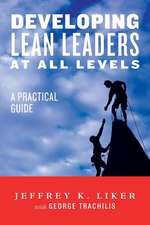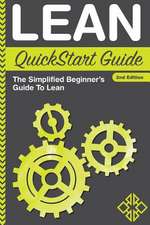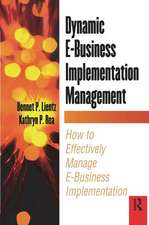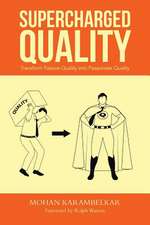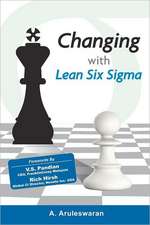True Kaizen: Management's Role in Improving Work Climate and Culture: Cărți Lean in, Lean Manufacturing, Lean Six Sigma, Kaizen
Autor Collin McLoughlin, Toshihiko Miuraen Limba Engleză Hardback – 13 noi 2017
Asourworkforcebecomesmoreknowledgeable,skillful,andmoreperceptiveoftheirneedsandwantsasemployees,theabilitytoreachthetruepotentialofanorganizationbecomesmoreandmoredifficult.Managersmustlookateachindividualelementofanequationlikethisinordertofullyunderstandhowtoachieveananswer.Theymustbegintoanswermorefocusedquestions,suchas:
1.Howproductiveistheexistingworkclimateandculture?
2.Howdoemployees,asindividuals,navigatetheexistingworkclimate?(Howdotheydealwithday-todayissueswitheachother?)
3.Whereandhowareindividualsandtheirworkprocessesassessed?
4.Whatobstaclesdoemployeesfaceeveryday,andaretheyempoweredtofixtheseobstacles?
5.Whatroledoesleadershipplayateachleveloftheorganization?(Lookingattheorganizationinlayersofmanagement.)
Toaddressthesechallenges,thisbookfocusesonthreemainaspectsofleadershipandmanagement:
1.AddressingandImprovingthePerspectiveofManagement--Theideaspresentedinthisbookarenotlimitedtoacertainindustryorfieldofwork,butcanbeappliedinanysettingbecausetheyspeaktoauniversalhumanelement.
2.ExploringandImprovingWorkClimate--Organizationsaresocialentities,operatingwithintheirowncontrolledenvironment.Thisbookwillexplorethefactorsthatcontributeto,andencourage,apositiveworkclimate.
3.ObservingandEliminatingWastefulWorkProcesses--Observingwastefulactivitiesandworkprocessesrequiresarefinedperspective.ThecasestudiespresentedillustratetheHowandWhytohelprefineexpertise.Thiswillalsoleadtothejoyandbenefits
Preț: 351.89 lei
Nou
67.33€ • 70.49$ • 55.71£
Carte tipărită la comandă
Livrare economică 05-19 aprilie
Specificații
ISBN-10: 1138745421
Pagini: 250
Ilustrații: 91 Line drawings, black and white; 22 Halftones, black and white; 91 Illustrations, black and white
Dimensiuni: 156 x 234 x 22 mm
Greutate: 0.5 kg
Ediția:1
Editura: Taylor & Francis
Colecția Productivity Press
Seria Cărți Lean in, Lean Manufacturing, Lean Six Sigma, Kaizen
Locul publicării:Oxford, United Kingdom
Public țintă
Professional and Professional Practice & DevelopmentCuprins
Notă biografică
Collin has lead over 40 Kaizen Study Missions to Japan to benchmark and mentor leading organizational leadership. He is recognized for designing, coaching, and advising some of the most influential businesses in the world, including Carl Zeiss, Seattle Children’s Hospital, Mars, Harvard Medical, Siemens, Heinz, and Dole just to name a few.
Collin has championed total organizational change across 12 different industries including healthcare. His knowledge of 21stCentury Kaizen has allowed him to author over 800 different books, training materials, workshop packages, and subject-based lesson videos to help organizations succeed at creating sustainable improvement systems.
Toshihiko Miura
Miura has helped organizations around the world achieve Kaizen transformations regardless of their industry. His Kaizen training is especially unique and invaluable as he first focuses on developing morale and the engagement level of each worker. After he confirms there is a true commitment toward Kaizen from every individual within an organization, he then guides companies through meaningful transformation.
He has learned the true meaning of Kaizen from Sensei Hitoshi Yamada, who is a direct student of Taiichi Ohno. He has worked with Yamada’s Personal Education Center (PEC) to spread this knowledge around Japan and has been a contributor to many of their publications.
Descriere
What does it take to manage an organization to success? No matter what industry you are in, an organization is primarily a group of people. This book focuses on that ever-important human element. In the rush to get 'lean', many organizations focus solely on tools for increasing productivity, but where do these tools come from? In this book, Collin McLoughlin and Toshihiko Miura look back on their decades of international consulting experience to examine how organizations around the world have transformed on a cultural level by respecting the people who work within them and leveraging their creativity to solve problems.
As our workforce becomes more knowledgeable, skillful, and more perceptive of their needs and wants as employees, the ability to reach the true potential of an organization becomes more and more difficult. Managers must look at each individual element of an equation like this in order to fully understand how to achieve an answer. They must begin to answer more focused questions, such as:1.
How productive is the existing work climate and culture?2. How do employees, as individuals, navigate the existing work climate? (How do they deal with day-today issues with each other?)3. Where and how are individuals and their work processes assessed?4.
What obstacles do employees face every day, and are they empowered to fix these obstacles?5. What role does leadership play at each level of the organization? (Looking at the organization in layers of management.)To address these challenges, this book focuses on three main aspects of leadership and management:1. Addressing and Improving the Perspective of Management -- The ideas presented in this book are not limited to a certain industry or field of work, but can be applied in any setting because they speak to a universal human element.
2. Exploring and Improving Work Climate -- Organizations are social entities, operating within their own controlled environment. This book will explore the factors that contribute to, and encourage, a positive work climate.
3. Observing and Eliminating Wasteful Work Processes -- Observing wasteful activities and work processes requires a refined perspective. The case studies presented illustrate the How and Why to help refine expertise.
This will also lead to the joy and benefits
















